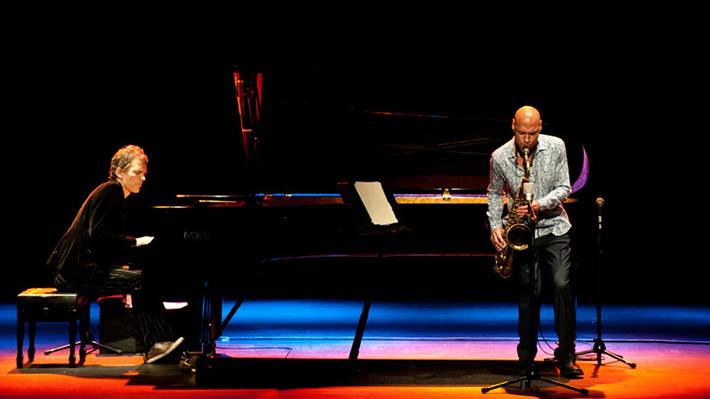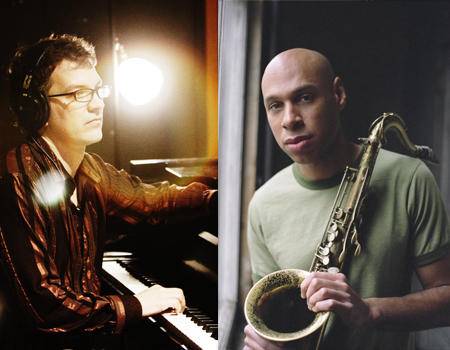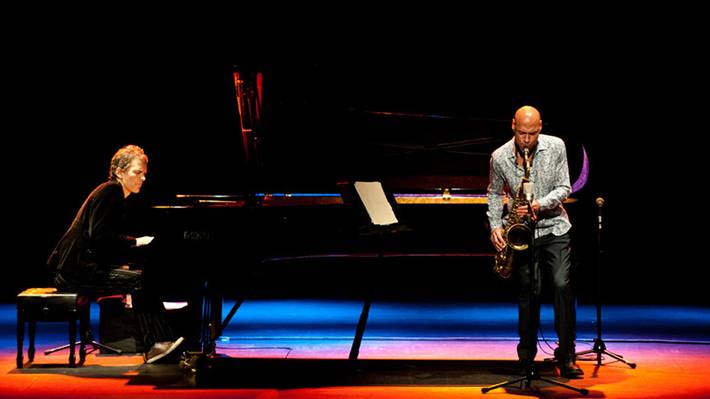
Joshua Redman and Brad Mehldau have a long history together, first meeting in New York’s dense jazz scene in the early 90’s and developing a musical relationship which would only grow stronger over the years. Recently, Joshua Redman recorded an album with The Bad Plus, a trio which was at Krannert Center only a couple years back to perform their magnificent rendition of The Rite of Spring, and Brad Mehldau has been making rounds with his trio and with his group Highway Rider, but for someone paying attention to the movement of jazz today, neither of these musicians need much of an introduction. Following the release of their album Nearness on September 9th through Nonesuch Records, they are touring every corner of the world. On the way, they were able to bless C-U with their inspiring and virtuous performance.
It was quite an eclectic audience which gathered in the lobby of Krannert Center last Friday evening to see a couple of the most relevant musicians in modern jazz playing together on the stage of the Tryon Festival Theatre. As the lights fell and hundreds of eyes fixed on the pearly-dark grand piano and two shimmering saxophones (one tenor and one soprano), Redman and Mehldau calmly walked on stage and bowed before taking up their places behind the instruments. The mere presence of the duo with their humble demeanor transformed the feeling of this large space into that of a comfortably lit living room. Before they began, Redman took a moment to shuffle through the paper on his music stand in search of something specific. He takes just long enough to raise a bit of anxiety in both Mehldau and the audience. When he finally hands the music over, Mehldau gives a sarcastic gesture, the wipe of his brow, and we all laugh. This wasn’t a comedy show, but these informal moments – that comedic relief – really adds to the intimacy and immediate comfort of the performance.

The duo held the audience’s attention for a little over an hour and a half, burning through seven tunes including an unplanned encore. They performed mostly originals, some without names, and a couple arrangements of the greats, including Thelonious Monk and Charlie Parker. Most of what they played is from the live-recorded Nearness. The first sounds heard were the deep yet airy contrasting sounds coming through Redman’s Tenor sax, as if he wanted to familiarize the listeners with the pure tone of his breath before Mehldau smoothly entered with complimentary chords. The opener, titled “Mehlsancholy Mode,” played on an oddly metered 5/4 time signature, but this was just an introduction to the rhythmic complexity to come. Based off of this first tune, one could immediately tell how rhythmically centric Mehldau is capable of playing.
It’s questionable that a duo would be able to fill such a large venue, but they did more than that. With just two performers on acoustic instruments, there is a sort of one-to-one relationship between the performer and the listener – a level of transparency that isn’t masked behind distorting effects that can be used to simply fill a space with more sound. This is what is especially beautiful about the elegant instrumentation of saxophone and piano and no drums or bass. Through a somewhat limited instrumentation like this, Mehldau and Redman perform all of the different functions that you could expect from a larger ensemble. They keep time, they dictate harmonies, and they illustrate beautifully improvised melodies. Rather than gaining depth through volume or additional dimensions of sounds, they develop emotional appeal through intellect. For example, the fourth piece they played was an arrangement of a Charlie Parker tune “Ornithology” and over the course of this piece they went to great harmonic and rhythmic depth, conversationally spiraling around and building off of each other’s phrases to provoke feelings which could not be expressed in any other form.
With a great level of talent, the duo is able to always move forward without a degree of stagnation. Listening to and watching these two play their instruments, putting all the passion they contained in their bodies into the music, was truly a wonder.








